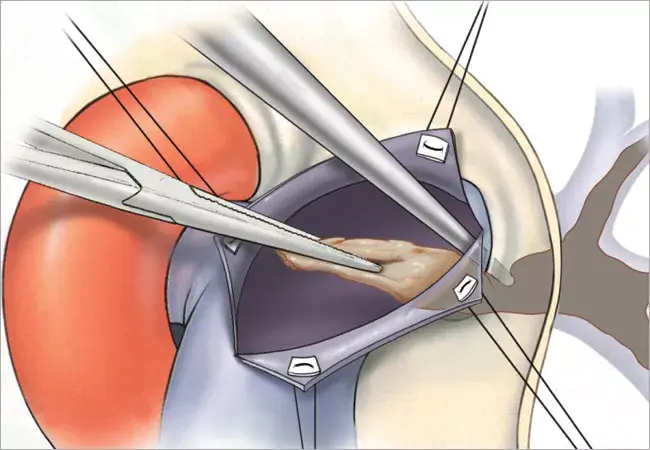Introduction
Pulmonary thromboendarterectomy (PTE) is a complex surgery to remove long-term blood clots from arteries in your lungs that can’t be treated with medication.
These clots persist and remain adherent to the artery wall. With time, the clots are replaced by scar tissue resulting in chronic obstruction of the pulmonary arteries, causing restricted blood flow and high blood pressure through the lungs. This rare condition is called chronic thromboembolic pulmonary hypertension (CTEPH).
 PTE specimen |
| Image credit |
Procedure
Pulmonary endarterectomy surgery is performed under general anaesthetic, which means that you will be asleep throughout your surgery. When you are asleep:
A breathing tube is put down your throat into your lungs – this is connected to a breathing machine called a ventilator
Two catheters are inserted in your neck – one is connected to a drip to give fluids and medicines, the other measures the pressures in your heart and lungs
One catheter is inserted into an artery in your wrist – to monitor your blood pressure and oxygen levels
One catheter is inserted into your bladder – to monitor your urine and kidneys.
Your doctor will:
Access your lungs by a cut through your breastbone (sternum)
Stop your heart for a short time - your body will be connected to a heart-lung machine which will take over the work of your heart and lungs
Your body will be cooled to 20 degrees
The blood will be drained from your lungs and heart
The heart lung machine will be stopped for a period
The surgeon will open your pulmonary arteries - one at a time
The surgeon will carefully clean out the blood clots and scar tissue from your pulmonary arteries
Your body temperature will be warmed to 37 degrees
Your heart will start again
The surgeon will close your chest using wires to hold your breastbone together and dissolvable stitches on your skin.
The surgery usually takes 6 - 8 hours to complete.
 |
| Image credit |
Risks
As with any surgery, there are some risks associated with a pulmonary endarterectomy. Some of these risks might include:
Abnormal heart rhythms (arrhythmias)
Bleeding
Fluid in the lungs (pulmonary oedema)
Infection
Kidney problems.
In extremely rare cases, there may be:
Death
Stroke - only seen in 2-3% of patients
Delineation of the true plane of dissection in pulmonary thromboendarterectomy. PA=pulmonary artery.Image credit
Recovery
Patient is shifted to the intensive care unit after completion of the procedure, where vitals, breathing, bowel function, discomfort, stitches, wound healing, chest tube drainage are monitored
Once the oxygen levels are normal and chest tubes are removed, a few test should be performed with include:
VQ scan – to check for changes to the pulmonary arteries after your surgery
Echocardiogram – to assess your heart function after your surgery.
Both of these tests should be repeated in six and 12 months’ time.Most people will require oxygen for a period of time after surgery while the lungs recover.
Recovery
Your medical team will help you with some of the physical aspects of your recovery, including:
Breathing exercises
Mobility
Physiotherapy routine
After surgery, most people do not suffer shortness of breath and have a much better quality of life.
You will require lifelong blood thinning medication, such as Warfarin, for the rest of your life to prevent clots from returning.

.jpeg)

No comments:
Post a Comment